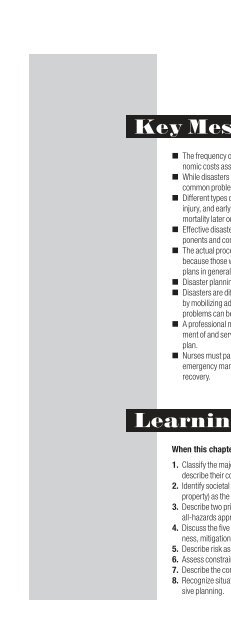Disaster Nursing and Emergency Preparedness - Springer Publishing
Disaster Nursing and Emergency Preparedness - Springer Publishing
Disaster Nursing and Emergency Preparedness - Springer Publishing
Create successful ePaper yourself
Turn your PDF publications into a flip-book with our unique Google optimized e-Paper software.
Key Messages<br />
■ The frequency of natural disasters, the individuals affected by them, <strong>and</strong> the economic<br />
costs associated with loss have been steadily increasing over recent years.<br />
■ While disasters are often unexpected, sound disaster planning can anticipate<br />
common problems <strong>and</strong> mitigate the consequences of the event.<br />
■ Different types of disasters are associated with distinct patterns of illness <strong>and</strong><br />
injury, <strong>and</strong> early assessment of risks <strong>and</strong> vulnerability can reduce morbidity <strong>and</strong><br />
mortality later on.<br />
■ Effective disaster plans are based on knowledge of how people behave. Key components<br />
<strong>and</strong> common tasks must be included in any disaster preparedness plan.<br />
■ The actual process of planning is more important than the resultant written plan<br />
because those who participate in planning are more likely to accept preparedness<br />
plans in general.<br />
■ <strong>Disaster</strong> planning must overcome apathy <strong>and</strong> complacency.<br />
■ <strong>Disaster</strong>s are different from daily emergencies; most cannot be managed simply<br />
by mobilizing additional personnel <strong>and</strong> supplies. Certain commonly occurring<br />
problems can be anticipated <strong>and</strong> addressed during planning.<br />
■ A professional m<strong>and</strong>ate exists that calls for nurses to participate in the development<br />
of <strong>and</strong> serve as an integral part of a community’s disaster preparedness<br />
plan.<br />
■ Nurses must participate as full partners with both the medical community <strong>and</strong><br />
emergency management community in all aspects of disaster response <strong>and</strong><br />
recovery.<br />
Learning Objectives<br />
When this chapter is completed, readers will be able to<br />
1. Classify the major types of disasters based on their unique characteristics <strong>and</strong><br />
describe their consequences.<br />
2. Identify societal factors that have contributed to increased losses (human <strong>and</strong><br />
property) as the result of disasters.<br />
3. Describe two principles of disaster planning, including the agent-specific <strong>and</strong> the<br />
all-hazards approach, <strong>and</strong> the basic components of a disaster plan.<br />
4. Discuss the five areas of focus in emergency <strong>and</strong> disaster planning: preparedness,<br />
mitigation, response, recovery, <strong>and</strong> evaluation.<br />
5. Describe risk assessment, hazard identification, <strong>and</strong> vulnerability analysis.<br />
6. Assess constraints on a community’s or organization’s ability to respond.<br />
7. Describe the core preparedness actions.<br />
8. Recognize situations suggestive of an increased need for additional comprehensive<br />
planning.

















